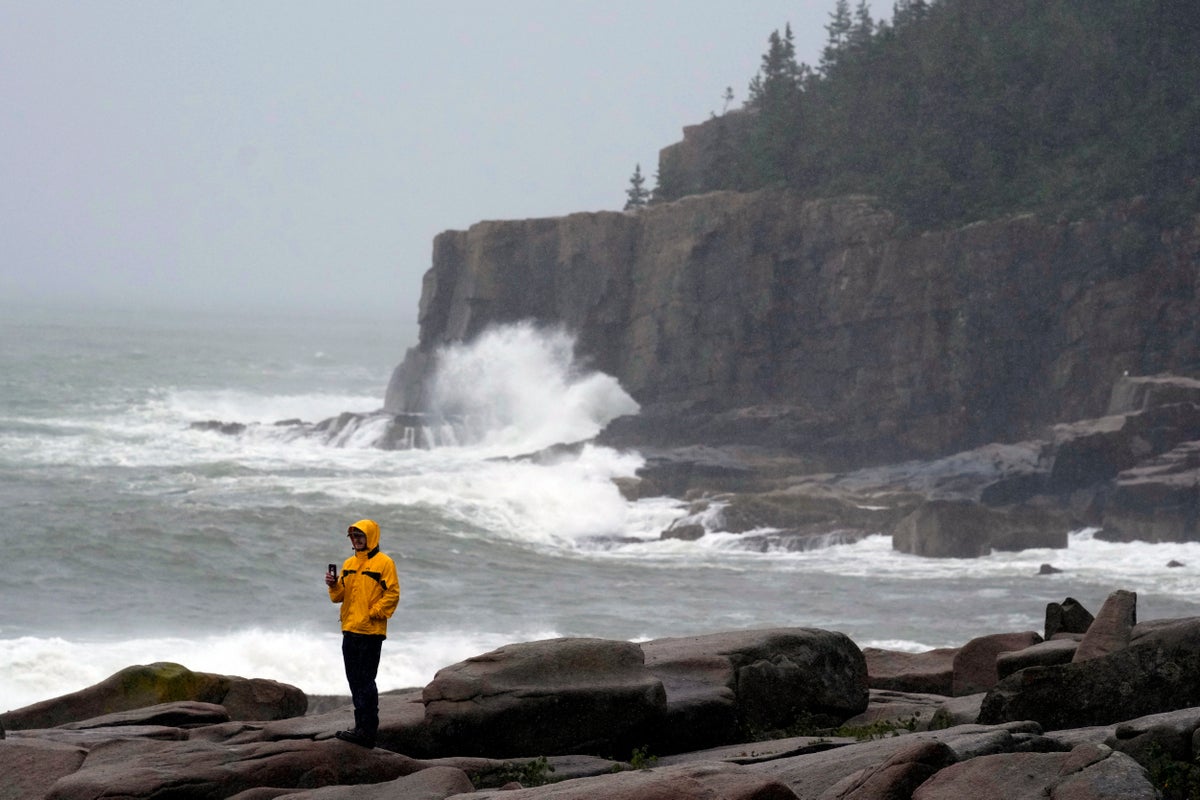
Post-tropical cyclone Lee has taken at least one life after it made landfall on Saturday afternoon, bringing hurricane-force winds and torrential rain to the east coast.
A 51-year-old motorist in Searsport, Maine, was killed after the gusts caused a large tree limb to topple onto his vehicle on Saturday on US Highway 1.
The tree limb also brought down live power lines, meaning utility workers had to cut power before the man could be removed, police chief Brian Lunt said. The 51-year-old later died at a hospital, the chief said.
Despite the fatality, officials are removing warnings about the storm. The US National Hurricane Center discontinued a tropical storm warning for the coast of Maine, while Environment Canada ended its tropical storm warning in New Brunswick.
The National Hurricane Center reported early on Sunday that the storm was 70 miles off of Charlottetown, Prince Edward Island, and about 180 miles off of Port Aux Basques, Newfoundland.
Maximum sustained winds, as of Sunday, were blowing at around 45mph, a decrease from yesterday’s winds. While the storm continues to knock out power for residents in Maine and parts of Canada, the post-tropical cyclone is expected to gradually weaken over the next couple of days, and Lee could dissipate on Tuesday, the hurricane center said.
A tropical storm warning remained in effect for parts of Nova Scotia, Prince Edward Island and the Magdalen Islands.
Earlier Saturday in Bar Harbor, Maine, a whale watch vessel broke free of its mooring and crashed onto the land, forcing officials to quickly offload 1,800 gallons of diesel fuel to prevent it from spilling into the ocean.
Lee’s heavy rain has also caused notable damage. Coastal roads in Nova Scotia were flooded. Ferries were taken out of service. The province’s largest airport — Halifax Stanfield International — cancelled all flights.
“People are exhausted," said Pam Lovelace, a councilor in Halifax. “It’s so much in such a small time period.”
Tropical-storm-force winds on Sunday were extending outward up to 290 miles from the center.
The storm was large and strong enough to cause power outages several hundred miles from its center. At midday Saturday, 11 per cent of electricity customers in Maine lacked power, along with 27 per cent of Nova Scotia, 8 per cent of New Brunswick and 3 per cent of Prince Edward Island.
The storm skirted some of the parts of Massachusetts that had already suffered severe flash flooding days earlier, when fast water washed out roads, caused sinkholes, damaged homes and flooded vehicles.
In eastern Maine, winds died down enough by late afternoon Saturday for utility workers to begin using bucket trucks to make repairs. Central Maine Power and Versant Power had hundreds of workers, including out-of-state crews, assisting the effort. As of Sunday, 40,000 Maine residents were reporting outages, according to Poweroutage.us.
“At this point, the storm is resembling a nor’easter,” said Sarah Thunberg, a National Weather Service meteorologist, referring to a type of fall and winter storm that was given its name due to the winds that blow from the northeast.
Cruise ships took refuge at berths in Portland, Maine, while lobstermen in Bar Harbor and elsewhere pulled traps from the water and hauled boats inland.
Billy Bob Faulkingham, House Republican leader of the Maine Legislature, and another lobsterman survived after their boat overturned while hauling traps before the storm hit on Friday, officials said.
The two men clung to the hull of the boat until help arrived, said Winter Harbor Police Chief Danny Mitchell, adding that the 42-foot boat sank.
“They’re very lucky to be alive,” Mitchell said.
Despite warnings to stay inside, many decided to risk going out.
Betsy Follansbee and her husband jogged to Higgins Beach in Scarborough, Maine, to watch surfers – some of whom were wearing helmets – paddling out to catch waves reaching 12 feet, which Follansbee called the biggest waves she had ever seen in her 10 years living there.
“We’re impressed that they’re bold enough to try,” Ms Follansbee said.
Lee isn’t too disimilar from 2012’s Superstorm Sandy. Both storms were once-strong hurricanes that became post-tropical cyclones before landfall. However, Lee was not expected to be nearly as destructive as Sandy, which caused billions of dollars in damage and was blamed for dozens of deaths in New York and New Jersey.
Lee’s impact was also not as severe as the effects of last year’s Hurricane Fiona, Canadian meteorologist Jill Maepea said, which washed houses into the ocean in eastern Canada, caused massive power outages in two provinces and swept a woman into the sea.
Destructive hurricanes are relatively rare so far north. The Great New England Hurricane of 1938 brought gusts as high as 186 mph and sustained winds of 121 mph at Massachusetts’ Blue Hill Observatory.







